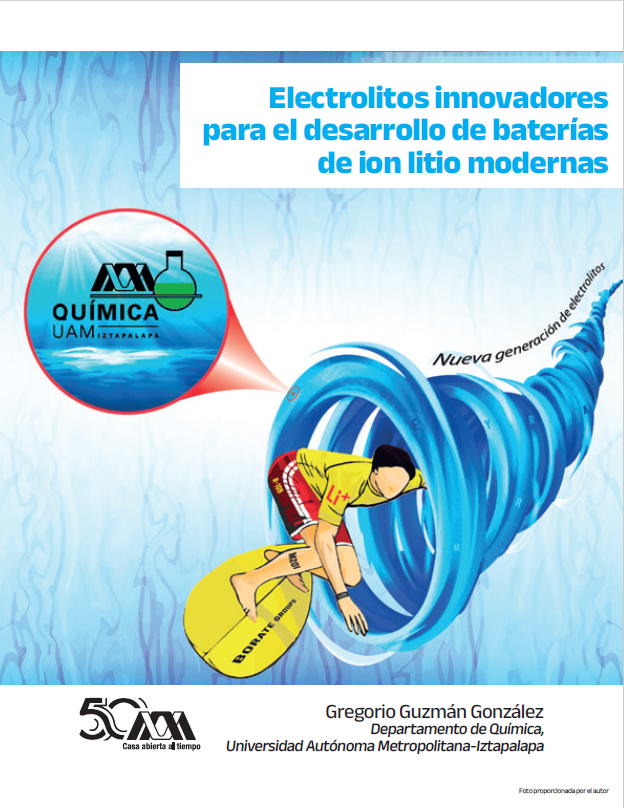Electrolitos innovadores para el desarrollo de baterías de ion litio modernas
Abstract
The growth of cities and population has increased international concern for the development of devices to facilitate the path towards energy transition. From the point of view of decarbonization, the development of electric mobility is one of the most promising paths, for which the development of energy storage devices with high gravimetric and volumetric density (light and small) is essential. In this sense, the development of lithium-ion based batteries has become one of the most relevant energy storage devices in the last decades. These types of batteries have been classified according to the nature of their electrodes as lithium-ion, lithium-metal, lithium-sulfur, lithium-air batteries. Where capacity and voltage are intrinsic properties of the chemical nature of the materials used for the development of the electrodes “anodes and cathodes” and the combination of them, respectively. On the other hand, the current density in batteries depends largely on the rate of transport of lithium ions across the different faces and interfaces of the battery. Therefore, the ionic conductivity of the electrolytes and binders as well as their compatibility with the rest of the cell components are a determining factor in the overall electrochemical performance of these devices. The main characteristics of the electrolytes and binders are presented here.
Downloads
References
Guzmán González, G. Brief Review of the Role of Polymers in Different Lithium- Ion Conducting Electrolytes for LIBs. J Mex Chem Soc 2023, 602–620. https:// doi.org/10.29356/jmcs.v67i4.1959.
Younesi, R.; Veith, G. M.; Johansson, P.; Edström, K.; Vegge, T. Lithium Salts for Advanced Lithium Batteries: Li–Metal, Li–O2, and Li–S. Energy Environ Sci 2015, 8 (7), 1905–1922. https://doi. org/10.1039/C5EE01215E.
Xu, K.; Zhang, S.; Jow, T. R.; Xu, W.; Angell, C. A. LiBOB as Salt for Lithium-Ion Batteries:A Possible Solution for High Temperature Operation. Electrochemical and Solid-State Letters 2002, 5 (1), A26. https://doi.org/10.1149/1.1426042.
Aravindan, V.; Gnanaraj, J.; Madhavi, S.; Liu, H.-K. Lithium-Ion Conducting Electrolyte Salts for Lithium Batteries. Chemistry – A European Journal 2011, 17 (51), 14326–14346. https://doi.org/https:// doi.org/10.1002/chem.201101486.
Society, E. A New Class of Electrochemically and Thermally Stable Lithium Salts for Lithium Battery Electrolytes: IV . Investigations of the Electrochemical Oxidation of Lithium Organoborates A New Class of Electrochemically and Thermally Stable Lithium Salts for Li. 1997.
Reddy, I. N.; Akkinepally, B.; Reddy, Ch. V.; Sreedhar, A.; Ko, T. J.; Shim, J. A Systematic Study of Annealing Environment and Al Dopant Effect on NASICON- Type LiZr2(PO4)3 Solid Electrolyte. Ionics (Kiel) 2020, 26 (9), 4287–4298. https:// doi.org/10.1007/s11581-020-03622-5.
Guzmán-González, G.; Vauthier, S.; Alvarez-Tirado, M.; Cotte, S.; Castro, L.; Guéguen, A.; Casado, N.; Mecerreyes, D. Single-Ion Lithium Conducting Polymers with High Ionic Conductivity Based on Borate Pendant Groups. Angewandte Chemie International Edition 2022, 61 (7),e202114024. https://doi.org/https://doi.org/10.1002/anie.202114024.
Alvarez-Tirado, M.; Guzmán-González, G.; Vauthier, S.; Cotte, S.; Guéguen, A.; Castro, L.; Mecerreyes, D. Designing Boron-Based Single-Ion Gel Polymer Electrolytes for Lithium Batteries by Photopolymerization. Macromol Chem Phys 2022, 223 (8), 2100407. https://doi.org/https:// doi.org/10.1002/macp.202100407.
Li, Z.; Fu, J.; Zhou, X.; Gui, S.; Wei, L.; Yang, H.; Li, H.; Guo, X. Ionic Conduction in Polymer-Based Solid Electrolytes. Advanced Science 2023, 10 (10), 2201718. https://doi.org/https://doi.org/10.1002/ advs.202201718.






